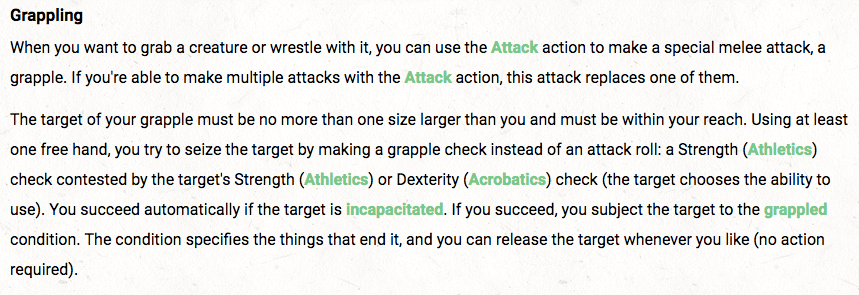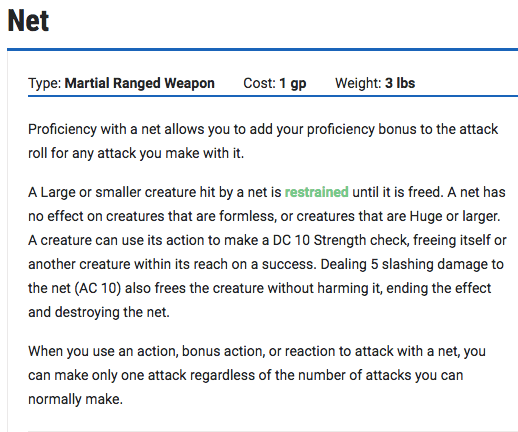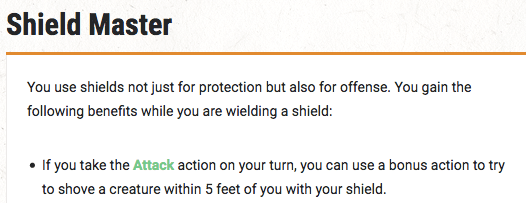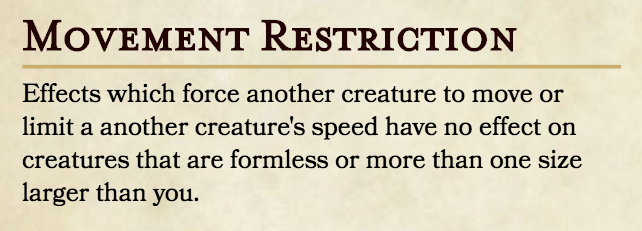There’s a variety of character features in 5th Edition D&D that allow you to manipulate another creature’s position on the battlefield. Yet, unlike grappling and shoving mechanics, many of these features are not limited by the target’s size. This produces some absurd results.
Sentinel Feat. An ancient dragon swoops down on the party to deliver a few melee strikes while its breath weapon recharges. As the massive dragon bats its wings to take back to the air, a PC with the Sentinel feat takes their opportunity attack, and hits. This reduces the dragon’s speed to 0 and it can’t escape because the fighter stabbed its toe.
Repelling Blast. The party is hunkered down in a fortification bracing for battle upon the arrival of a leviathan. Thankfully for the party, their warlock has taken the Eldritch Invocation Repelling Blast. So, each time the warlock hits the leviathan with an Eldritch Blast, they knock the colossal creature back 10 feet for each beam of Eldritch Blast. That’s 40 feet at level 17+, which, coincidentally, is the exact land speed of a leviathan.
Lightning Lure. A gargantuan shield guardian blocks the only means of ingress to a temple holding an ancient and powerful artifact. The temple has remained untouched for centuries under the guardian’s watch, until a level one spellcaster comes by and ropes it out of the way with a cantrip.
Does it really make sense for our small-to-medium sized heroes to freely push around titanic threats? For me, it breaks my immersion. First, it just doesn’t make sense. Second, it trivializes the perceived threat of really big creatures, who should make the characters tremble with fear, not get pushed around like a runt on the playground.
Size Limitations
Grappling. Grappling is limited to creatures two sizes larger than you:

Shoving. Shoving is limited to creatures two sizes larger than you:

Nets. Nets only work on creatures large or smaller:

Formless Creatures
Nets provide an additional limitation that we don’t see elsewhere in the rules: they don’t work on “formless” creatures.
While formless is not a creature feature you’ll find listed in monster stat blocks in the Monster Manual, Volo’s Guide to Monsters, or Mordenkainen’s Tome of Foes, we can divine which creatures may be immune by looking to their condition immunities. Formless creatures are typically immune to conditions such as paralyzed, prone, and restrained.
Based on that criteria, formless creatures include: air/fire/water-based elementals, oozes, incorporeal undead, and swarms. Ultimately, though, it’s the DM’s call. Feel free to lump in some aberrations like the gibbering mouther, if you see fit.
It’s pretty easy to see how we can extend this formless limitation to other movement effects. If it can’t be locked down, how can it be pushed around?
Solution: Size Cap
There’s two theories of thought on how we can fix this:
- A size cap based on the target, or
- A size cap based on the user.
While grapple and shove are limited based on the size of the user, these are mundane effects, not magical effects. There’s a good argument to be made that effects that come from feats or class features are more supernatural, if not outright magic, and deserve greater leeway.
After all, does it make sense for an Eldritch Blast to have a different size limitation based on the size of the caster? Not really. The damage is the same, so the effect should be the same. Your patron does not care about your stature.
On the other hand, non-magical feat based effects make perfect sense in terms of tying the size limitation to the user. Shield Master does this well by using the shove mechanic:

If shove is tied to a size limitation, it makes sense that a shove induced by the Shield Master feat should have the same limitation. We can extend this same logic to the Sentinel feat, although it doesn’t have a corollary in the base rules.
One issue with putting a hard cap on the size of the target is that it will not scale up if the user is enlarged. Shouldn’t an enlarged PC have a greater capacity to shove or stop an even bigger creature? Narratively, it makes sense.
Ultimately, the rule you decide to employ could be catered to the party composition. If you have both Warlocks and Sentinel users, you can provide different rules for magical effects and feat-based effects. Since this can get pretty fiddly, I’d recommend against doing it unless it’s necessitated by your party composition.

Reblogged this on DDOCentral.
LikeLike
In terms of grappling, what do you think of reducing the speed of a creature of one size larger than you or smaller to 0, halving the speed of two sizes larger, or just climbing on top of a creature 3+ sizes larger?
LikeLike
I think it’s a great change!
LikeLike
I think to restrict movement like that is a bit much, but inspired through your post I gave my genius loci a new feature:
**Landscape feature.** The genius loci can’t be moved by any spell or effect more than 5 ft. per turn.
LikeLike
I think to restrict movement like that is a bit much, but inspired through your post I gave my genius loci a new feature:
**Landscape feature.** The genius loci can’t be moved by any spell or effect more than 5 ft. per turn.
LikeLike